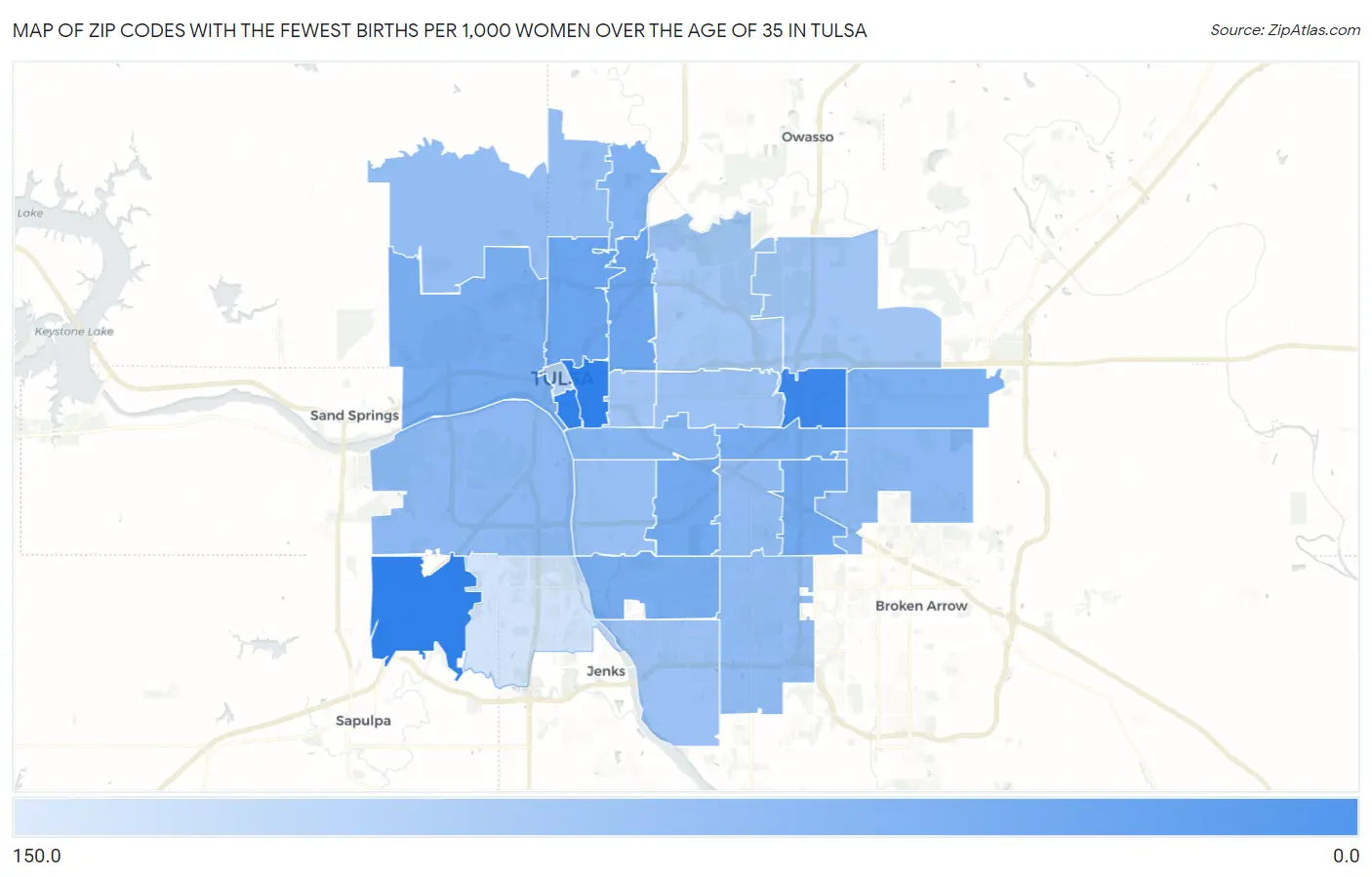Zip Codes with the Fewest Births per 1,000 Women Over the Age of 35 in Tulsa, OK
RELATED REPORTS & OPTIONS
Lowest Birth Rate | Women 35+
Tulsa
Compare Zip Codes
Map of Zip Codes with the Fewest Births per 1,000 Women Over the Age of 35 in Tulsa
113.0
7.0

Zip Codes with the Fewest Births per 1,000 Women Over the Age of 35 in Tulsa, OK
| Zip Code | Births / 1,000 Women | vs State | vs National | |
| 1. | 74128 | 7.0 | 28.0(-21.0)#18 | 32.0(-25.0)#880 |
| 2. | 74106 | 18.0 | 28.0(-10.00)#79 | 32.0(-14.0)#4,047 |
| 3. | 74110 | 19.0 | 28.0(-9.00)#92 | 32.0(-13.0)#4,364 |
| 4. | 74135 | 20.0 | 28.0(-8.00)#97 | 32.0(-12.0)#4,640 |
| 5. | 74146 | 20.0 | 28.0(-8.00)#98 | 32.0(-12.0)#4,656 |
| 6. | 74129 | 21.0 | 28.0(-7.00)#103 | 32.0(-11.0)#4,948 |
| 7. | 74136 | 22.0 | 28.0(-6.00)#107 | 32.0(-10.00)#5,224 |
| 8. | 74127 | 22.0 | 28.0(-6.00)#109 | 32.0(-10.00)#5,299 |
| 9. | 74108 | 25.0 | 28.0(-3.00)#136 | 32.0(-7.00)#6,277 |
| 10. | 74130 | 26.0 | 28.0(-2.00)#143 | 32.0(-6.00)#6,651 |
| 11. | 74114 | 29.0 | 28.0(+1.000)#151 | 32.0(-3.00)#7,443 |
| 12. | 74134 | 33.0 | 28.0(+5.00)#170 | 32.0(+1.000)#8,547 |
| 13. | 74107 | 33.0 | 28.0(+5.00)#171 | 32.0(+1.000)#8,556 |
| 14. | 74145 | 35.0 | 28.0(+7.00)#181 | 32.0(+3.00)#9,128 |
| 15. | 74133 | 36.0 | 28.0(+8.00)#186 | 32.0(+4.00)#9,269 |
| 16. | 74126 | 37.0 | 28.0(+9.00)#192 | 32.0(+5.00)#9,633 |
| 17. | 74105 | 40.0 | 28.0(+12.0)#211 | 32.0(+8.00)#10,205 |
| 18. | 74137 | 44.0 | 28.0(+16.0)#219 | 32.0(+12.0)#11,061 |
| 19. | 74112 | 44.0 | 28.0(+16.0)#220 | 32.0(+12.0)#11,075 |
| 20. | 74104 | 47.0 | 28.0(+19.0)#234 | 32.0(+15.0)#11,617 |
| 21. | 74116 | 47.0 | 28.0(+19.0)#235 | 32.0(+15.0)#11,664 |
| 22. | 74115 | 50.0 | 28.0(+22.0)#243 | 32.0(+18.0)#12,078 |
| 23. | 74103 | 70.0 | 28.0(+42.0)#286 | 32.0(+38.0)#14,207 |
| 24. | 74132 | 113.0 | 28.0(+85.0)#315 | 32.0(+81.0)#15,720 |
1
Common Questions
What are the Top 10 Zip Codes with the Fewest Births per 1,000 Women Over the Age of 35 in Tulsa, OK?
Top 10 Zip Codes with the Fewest Births per 1,000 Women Over the Age of 35 in Tulsa, OK are:
What zip code has the Fewest Births per 1,000 Women Over the Age of 35 in Tulsa, OK?
74128 has the Fewest Births per 1,000 Women Over the Age of 35 in Tulsa, OK with 7.0.
What is the Number of Births per 1,000 Women Over the Age of 35 in Tulsa, OK?
Number of Births per 1,000 Women Over the Age of 35 in Tulsa is 35.0.
What is the Number of Births per 1,000 Women Over the Age of 35 in Oklahoma?
Number of Births per 1,000 Women Over the Age of 35 in Oklahoma is 28.0.
What is the Number of Births per 1,000 Women Over the Age of 35 in the United States?
Number of Births per 1,000 Women Over the Age of 35 in the United States is 32.0.